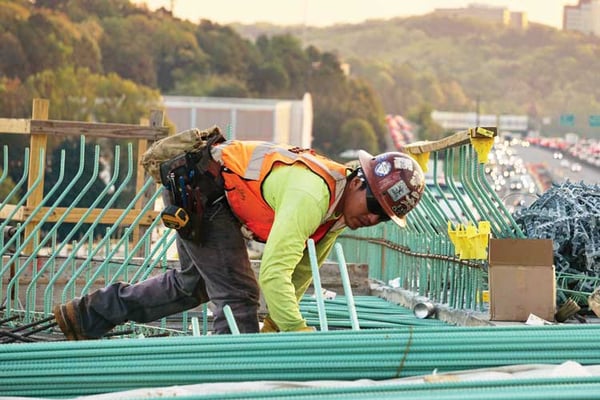The assembly of the rebar mesh for reinforcement requires several methods of fastening, and one of those methods is welding. Following AWS 1.4/D1.4M:2011, when welding rebar will ensure the integrity of the reinforced structure (composite reinforced concrete).

If a manual arc welding of reinforcing steel is required, the weldability of the reinforcing steel and the welding procedures compatibility needs to be carefully considered and strictly supervised. Using the chemical composition of steel that is described by the Carbon Equivalent (CE) number, we determine the weldability of the steel.
8 Carbon Equivalent Facts to Know When Welding Rebar
1. The primary hardening element in steel is carbon.
2. The hardness and tensile strength are inversely related to the ductility and weldability. Therefore, as the carbon content increases up to 0.85%, so does hardness and tensile strength.
3. As ductility and weldability increase, the Carbon content will decrease.
4. CE is an empirical value in weight percentages that is related to the combined effects of different alloying elements used in making carbon steel, or an equivalent amount of carbon.
5. The higher the weldability of the material, the lower the CE value.
6. A mathematical equation is used to calculate the value. The welding code provides two expressions when calculating the CE. The minimum preheat and interpass temperatures are determined from Table 5.2 of the code once the CE number is calculated.
7. It is not uncommon in alterations and building additions of existing structures for material test reports to be unavailable and the chemical composition to not be known. When this occurs, the code requires the highest preheat and interpass temperature for desired reinforcing bar size to be set to:
a. 300° F (150° C) for number 6 bars and smaller
b. 500° F (260° C) for number 7 bars and larger
8. The preheat and interpass requirements are somewhat relaxed when the chemical composition for ASTM A706 is not known or obtained. The preheat requirements are as followed:
a. No preheat is required for number 6 bars and smaller
b. 50° F (10° C) for number 7 to number 11 bars
c. 200° F (90° C) for number 14 and larger
d. When the material is below 32° F (0° C), the Code requires the material to be preheated to at least 70° F (20° C) and be maintained during the welding process (As with all welding).
AWS 1.4/D1.4 Requirements: Welding Reinforcing Steel Bars
Section 4 & 5
In sections 4 and 5 of the Code the respective allowable stresses and structural details can be found. Here, a wide range of details are given including, direct butt joints, indirect butt joints, lap joints, and interconnection of precast members. Consider the effects of eccentricity when designing lap joints if the external restraint is not provided.
Section 6
The workmanship regarding the development of the base metal, joint assembly, distortion, and quality are addressed in Section 6. It is not permitted to weld bars which cross and weld within two bar diameters from the points of tangency for the radius of bent bars. Local embrittlement of reinforced steel can develop from cross bar welding.
When reinforcing rebars are already embedded in concrete, to prevent spalling or cracking of concrete or destruction of the bond between the concrete and steel, allowances must be made for thermal expansion of the steel. Acceptable and unacceptable fillet and groove weld profiles are illustrated in Section 4 of the code.
Section 7
Welding techniques are discussed in Section 7. The technique includes the selection of filler metal, minimum preheat and interpass temperatures, welding environment, arc strikes, cleaning, the progression of welding, coated base metal, and welding electrodes. Shielded metal arc welding (SMAW), gas metal arc welding (GMAW), or flux cored arc welding (FCAW) are allowed welding processes. Other methods may be used when approved by the Engineer of Record.
It is critical to select the right welding electrodes that are compatible with the base metal material. An incorrect choice may lead to micro-cracking in the heat affected zone, which may lead to joint failure.
Unless they adhere to all design and control requirements of D1.4 tack welds are not allowed. The rebar at the weld becomes susceptible to a metallurgical notch effect and weakening when a tack weld is used.
Section 8
Section 8 pertains to the welder qualifications and inspections, respectively. Qualified welders must perform all structural welding, and qualified inspectors must inspect the work. When tested, WPS qualification must include specific joint type and size to be welded.
Inspectors must also be qualified. Acceptable requirements include AWS certification, Canadian Welding Bureau certification, or an Engineer/Technician trained or experienced in metal fabrication, inspection, testing, and who is qualified to perform the inspection of the work.
The Engineer of Record might request proof of the welder’s qualifications. The following sample forms for informational purposes are included in Annex A: Procedure Qualification Record (PQR), Welding Procedure Specification (WPS), and Welder Qualification Test Record.
It’s crucial to have Procedure Qualification Records (PQR), Welding Procedure Specifications (WPS), and Welder Qualification Test Records when welding rebar to assure structural integrity. CEI’s Pro-Write application provides all of these records. For more information on ProWrite, click here.
Resource:



Leave a Comment